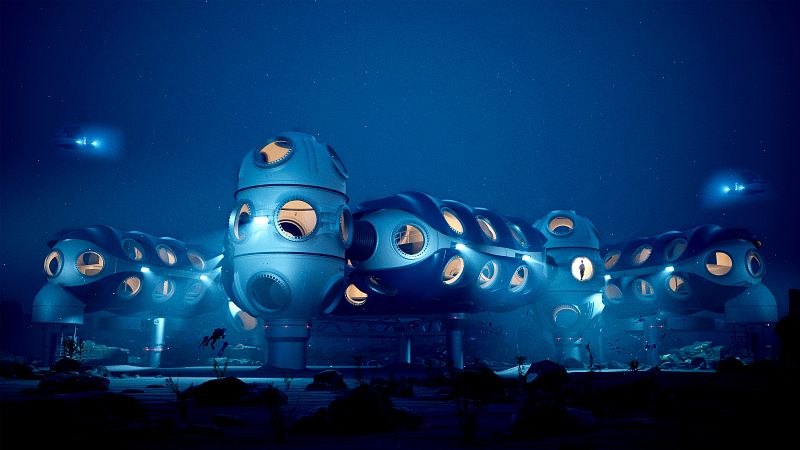Humans could one day live in bases on the ocean floor using these underwater pods

Wouldn't it be amazing to spend extended periods of time immersed in the underwater world, going beyond the usual temporary forays into the marine environment and instead making it your home for days, weeks, or even months, where the sights, sounds, and experiences are fresh and distinctive each day.
A British company is developing underwater living spaces for extensive human ocean exploration.
"We took a step back and acknowledged that the ocean, especially what lies beneath the ocean's surface, is still one of the few areas of the planet that we know very little about," said Sean Wolpert, the president of DEEP.
"We have the capabilities to spy on space, study near space, and monitor our surroundings on land and in the oceans, so what struck us was the disparity between our connection to the ocean as a species and our physical observations of it, not just objectivity-wise, but emotionally as well," he said.
The maritime exploration and technology firm has announced plans to unveil its inaugural habitat, Vanguard, within the next two years.
The Vanguard module measures 12m in length and 7.5m in width and is designed to accommodate up to three individuals at a depth of 100m. It serves as a testbed for the Sentinel habitat, a more advanced version expected to be deployed in 2027.
Deep's Vanguard is more tailored to short-term projects with specially trained divers. In contrast, the Sentinel is intended for longer-term research, accommodating a team of up to six people for tours of up to 28 days at a depth of approximately 200 metres.
Sentinel will feature wet and dry laboratories, as well as a moon pool – a design that enables divers to move easily between the ocean and the habitat.
This will facilitate researchers in collecting and examining samples from the ocean floor in real-time, thereby eliminating the requirement to return to the surface.
Making the ocean 'sexy'
DEEP describes itself as "what SpaceX is to the space agencies for global navies and oceanographic research groups".
The company thinks that global navies keeping a watch on vital underwater infrastructure will benefit from the undersea habitats.
"Clearly, the international navies will be keenly interested. One of the most fiercely contested zones is that of vital subsea infrastructure. The majority of the data we access passes through underwater cables," Wolpert stated.
Undersea fibre-optic cables, which carry more than 95 per cent of international internet traffic, in accordance with NATO, and pipelines used for transporting oil and gas, are susceptible to deliberate disruption.
In recent years, Europe has witnessed a series of incidents involving deliberate acts, including the sabotaging of the Nord Stream pipelines in 2022, an issue with the Balticconnector gas pipeline in 2023, and damage to an undersea cable in the Baltic Sea following an unfortunate event in 2024.
One has to look at the crucial transportation of oil and gas, a significant portion of which flows through subsea pipelines. As such, maintaining the integrity of this essential infrastructure is of utmost priority for navies worldwide.
Sentinel could be used as a submersible research facility for marine biologists exploring the deep-sea environment, as well as serving as an engaging underwater attraction, akin to a large aquarium.
Mr Wolpert explained that the group's ambition is to create the equivalent impact that SpaceX had when it regenerated interest in space exploration and made it a fashionable and exciting topic.
"What we're aiming for, if I may be so bold, is to replicate the SpaceX model, offer that platform, and enable prospects to draw in the best brains who wish to make a difference and drive innovation in the ocean," he added.
Constructed by automated assembly using three-dimensional printing machines
Cooked by a method called wire-arc additive manufacturing, Sentinel is being constructed using six 3.5 metre tall robots, as reported by DEEP.
This process is akin to a massive 3D printer, but unlike traditional plastic, it employs metal wire, meticulously constructing the framework, layer by layer, to guarantee the enclosure's durability in withstanding the crushing pressure of the deep ocean.
"We are manufacturing in a more intelligent manner. Instead of dismantling traditional manufacturing approaches, we're creating systems that generate considerably less waste," Wolpert stated.
DEEP claims the submerged living areas can be rebuilt and relocated with ease, thanks to their modular and transportable design, resembling assembly and reuse of building blocks like Legos.
"It's possible to have your bunks on the top deck in one area of the ship, and then another area connected to it, which can be adapted to create an entire laboratory. This would then allow for easy communication with colleagues in a traditional laboratory on land," Wolpert explained.
Vanguard's initial operational deployment site remains to be specified, but partners at DEEP are currently engaged in discussions with prospective clients in both Europe, the Middle East, and North America.
For more on this story, please click on the media player above.
Post a Comment for "Humans could one day live in bases on the ocean floor using these underwater pods"